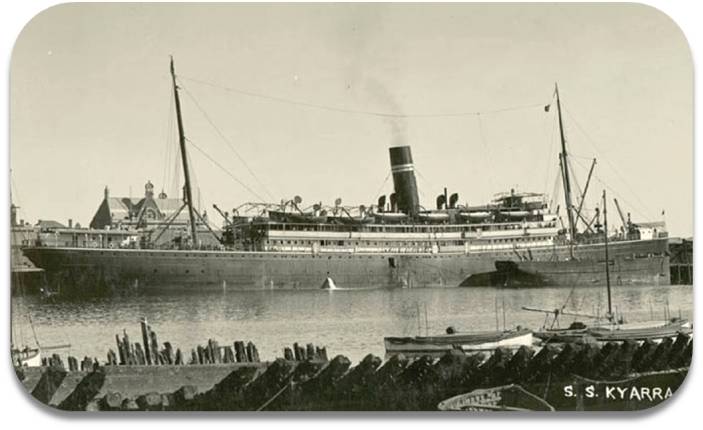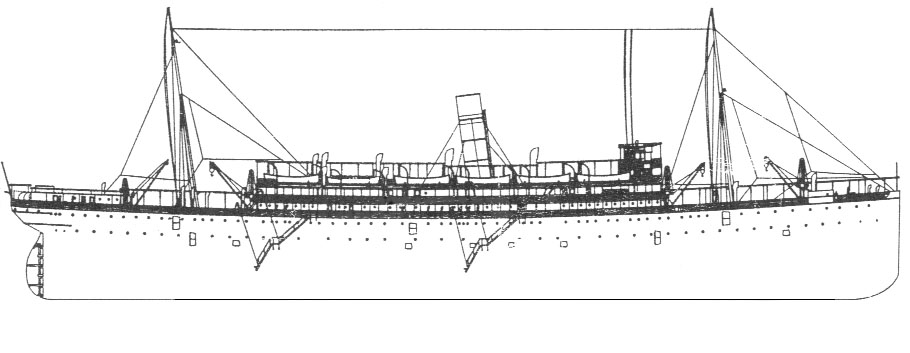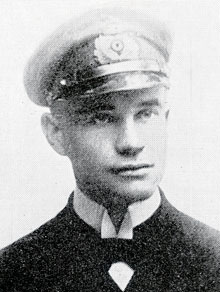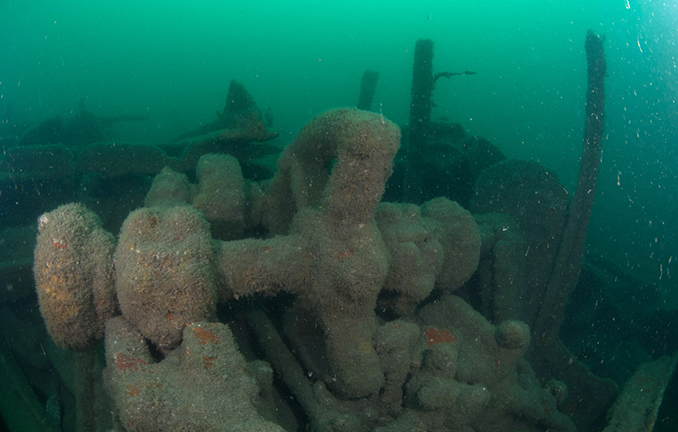Twelfth of March 1994, I am back from Cyprus and the Blue water diving is officially over……it’s back to the South Coast and the wreck of the Kyarra off Swanage. I’m diving with Steve, another TIDSAC diver and it is the first dive “Tich” Tichener (another former Royal Navy sailor operating a dive-boat, the “Kyarratoo” out of Weymouth), has taken this season. The Kyarra was a beautiful ship, built by Denny’s of Dumbarton as a luxury liner in 1903, she has sleek lines and sits well in the water…….

I wanted to dive Kyarra since hearing of her, many times, whilst diving around the South coast. Kyarra was one of the easiest wrecks to get to, being close to Swanage, and there were plenty of boats that would take you out to her, Tich was our choice as he was, like us, from a services background, it made things easier as we all spoke the same (tribal) language. On this occasion we had headed down in a bit of a rush and were kitting up on the boat deck, unusual as I prefer to be suited and booted before we sail on short trips…… Kyarra had been commissioned by the Australasian United Steam Navigation Company for service to and round Australia, and was launched into the river Clyde on February 02nd of 1903 being registered in Freemantle, Australia, although her owners and “flag” were London registered. Kyarra would spend 10 unremarkable years sailing between her home port and Sydney until the looming of World War 1 on the global horizon…………

The Australian government met the call to arms of the mother-country, when, in 1914, the UK asked all commonwealth countries to aid in the struggle against the Kaizer and his Austro-Hungarian and German Army! On the 6th November of 1914 Kyarra became the “HMAT A.55 Kyarra” , requisitioned in Brisbane and intended to act as a medical unit transport ship, supporting the Egyptian theater of battle (Wikipedia). The work of hospital ships would turn out to be as dangerous perhaps as that of troop transports, several would fall to U-Boat action, despite the clear and obvious hospital markings!

However Kyarra would survive her brief period as a hospital ship and be transferred to troop carrying duty by March of 1915, barely 5 months later. Kyarra was named after the pelt of the native Australian “Possum”, the word being Aboriginal for a small strip of the creature’s fur, perhaps it was intended to refer to her sleek looks, or perhaps it was just a whim of the owners……… The technical bit, for those who enjoy such things, goes like this: Kyarra was 6953 Tonnes (Gross) and 415 feet 5 inches long with a beam of 52 foot 2 inches and a draught of 31 foot 5 inches. She was powered by Two triple expansion steam turbines and capable of 15.4 Knots (just shy of 18mph). Kyarra could carry 2600 Tonnes of cargo and 286 passengers, 126 of those being “1st Class” (Wikipedia) which, in the day, meant exactly that, Kyarra being intended for luxury travel!

Kyarra almost made it through the war, she came to lie in the channel, off Swanage, following an attack by UB 57 under the command of Johannes Lohs, just off Anvil point, outside Weymouth. Kyarra was sailing from Tilbury to Devonport, travelling light, carrying civilian passengers and expecting to take on cargo on arrival (Wikipedia). UB 57 was commanded by Johannes Lohs who had begun his career as a “Seekadett” in the Kreigsmarine 01st April 1909, just Six years following Kyarra’s launch. Lohs had a long career by the time he crossed paths with Kyarra, by then, on the 26th of May 1918, he had risen to the rank of “Oberleutnant zur See” and was a holder of the Iron Cross, 1st class, as a result of his successes with other U Boats. Like many of his peers, Johannes Lohs did not survive the war, his body washing up on the Dutch coast 21st August 1918 after UB 57’s last contact with controllers, 14th of August ’18, when Lohs was said to be homeward bound, somewhere off the Sandiette bank in the Dover Straits. At that point Johannes Lohs had sunk an estimated 165,000 Tonnes of allied shipping (U-Boat Net)

Our dive on the Kyarra started off with a wicked current running when we arrived, kitting up gave us a bit of time to see the current seemingly drop a little and we entered onto the shot line mid afternoon on the 12/03/1994……This was an uneasy descent, Steve dropped his torch and chased it off the shot-line, forcing me to either follow, or end up separated from Steve which would effectively abort the dive, neither of us would want that, so I followed…….. What follows shows how easy it is to make mistakes, which just compound…….The assumption on my part, when Steve suggested the Kyarra, was that Steve had dived it before, our haste to get kitted before it started to get dark meant the brief was just a buddy-check, and then the separation from the shot line meant, effectively, in the bloody poor viz, (about 1/2m at very best, in torch-light) that we were pretty much blind! Here’s what my log book says….. “Missed the shot line in nil viz-total black-out after 15m. Onto a sandy bottom full of wreckage, when finning against a 2kt current water went “dead” figured we’ed entered the hull inadvertently-no viz even on torches past 1/2m. Very dangerous not knowing if we had wreckage overhead. 16 mins gone by now so we ended the dive….very apprehensively…ascent was clear thank God…...”

What isn’t apparent here is what I was feeling at the time, If we’ed been tied off on the shot line I’d have been happier by far, following a line is my default setting in low viz on a new wreck, too many have died trapped inside wrecks, that is not the way I want to go! I was seething with myself for not asking the right questions before the dive, my dive slate said it all “…….can you enter the wreck….?” Steve shrugged (I got madder) “…..are we inside it.…?” Steve shrugged (I got even madder) ” ……dive over….” Steve, bless him, agreed and we turned 180 degrees and swam with the current for couple of minutes before I deployed the SMB. It was a huge relief when the water became lighter, and I realised the SMB was at the surface, not under a hull-plate……..lesson learned! Talking with Tich after we exited the water, he believed that at 29m or so, we had swam under the stern of the Kyarra which was what shielded us from the relentless current, and what had caused me to stop in my tracks thinking we had entered part of the hull. Showing the dive slate to other members of TIDSAC that evening was a sobering and humbling experience, one I have not forgotten to this day………..
